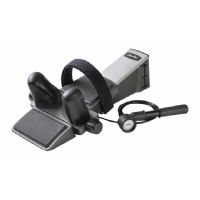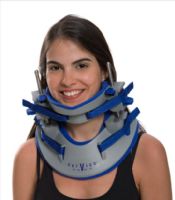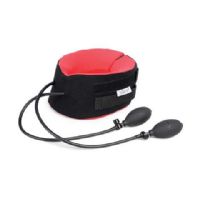 Written by Amanda Marten, MSN, APRN, FNP-C
Written by Amanda Marten, MSN, APRN, FNP-C
Most of us spend a lot of time on our phones or in front of computer screens. This can contribute to poor posture and cause neck pain. About one-fourth of the people who visit outpatient clinics are seeking relief from neck pain. Cervical traction uses force and counterforce to pull bound-up muscles and ligaments and compressed discs in opposite directions. This usually involves pulling one way and adjusting a counterweight in the other direction. It is a valuable tool in the nonsurgical management of neck issues like disc degeneration, arthritis, and neck strains and sprains, and is usually done two to three times per week. If your neck pain is severe enough to keep you from venturing out, or if you have a schedule that isn’t conducive to multiple office visits per week, using a home cervical traction device allows you to take treatment whenever you want in the privacy of your own home.
Using cervical traction dates back to the fourth century BC. It uses force or tension to pull the head away from the neck. Creating space between the vertebrae relieves compression, stretches the vertebrae, ligaments, and muscles, and relieves pain and pressure. This allows the muscles to relax, lengthening and stretching them along with the joints in the neck area.
Decompressing the discs and relaxing the surrounding muscles can help relieve muscle spasms, pain from sprains, aching joints, pinched nerves, and cervical spondylosis. Alleviating these issues leads to better alignment, range of motion, and mobility and reduces the discomfort that can limit your daily activities.
 | Saunders Cervical Traction Device for Home Use by DJO Global View Product |
Pneumatic devices are used in professional settings and for home use. When using one of these cervical traction devices at home, you lay on your back on the floor or bed with the device under the head and shoulders. Straps hold your head in place, and you can adjust the tension that pulls your head away from your body, extending the neck, stretching the muscles, and increasing the space between the vertebrae. Pneumatic home traction devices can deliver up to 50 pounds of tension. These home neck traction devices deliver treatment similar to what is provided in professional therapy sessions, without having to leave the comfort and privacy of your own home. Usually, pneumatic devices have gauges that allow you to control the level of pressure precisely, as the gauge shows you the exact amounts of pressure.
 | Cervico2000 Cervical Decompression Device by Meditrac View Product |
If laying immobilized to take treatment doesn’t appeal to you, using a wearable brace for home cervical traction allows you to freely move around and conduct your daily activities during your treatment. These devices can improve spine alignment, stretch the neck to alleviate muscle tension and stiffness, and provide pain relief in the neck and shoulders. They are available in several designs, but the best options for wearable braces are the larger models that distribute the pressure around the neck, rather than smaller options that concentrate pressure under the chin.
 | Inflatable Trac Collar by Advanced Orthopaedics View Product |
Inflatable home cervical traction devices are less expensive than pneumatic models. They are also less sophisticated, are not as adjustable, and deliver less pressure than can be achieved with pneumatic versions. Some inflatable models allow you to use them while laying down or standing up and moving about. They are very easy to use and increase user-directed traction at a pace set by the user.
.jpg&newwidth=365&maxheight=200) | NeckPro II Over Door Cervical Traction System View Product |
Over-the-door cervical traction devices can be used at your home or office and provide the least expensive delivery system for home neck traction. You use this device while standing. A harness or sling is strapped to your head and neck and attached to a rope and pulley system over a door. It could include weight at the end of the rope, or you can manually pull on the cord to initiate the stretch. The cervical traction is applied by suspension. Some over-the-door models are complicated, using water bags as counterweights, while simpler designs use pulley systems or springs and ratcheting systems to create traction. Cervical traction applied by suspension is one of the oldest methods, dating back to the late 1800s. Since then, pneumatic devices and wearable braces have become the most popular. Today, over-the-door devices are considered outdated.
The standard range of traction pressure during physical therapy is between 25-45 pounds. For chronically tight muscles, higher pressure can provide a more effective stretch and provide more symptom and pain relief. Some home cervical traction devices can supply pressure up to 50 pounds. However, that’s not always a requirement for pain relief. For muscles and discs that are not as seriously compressed, a home neck traction device offering 10 pounds or less of pressure can provide effective treatment. If you are unsure of what amount of pressure is right for you, consult with your doctor.
Traction is not a one-size-fits-all treatment. For people whose vertebrae are severely compressed, research has shown an inclined position creates greater intervertebral separations on both the anterior and posterior sides and is more beneficial for people who are suffering from substantial symptoms. Not all home neck traction devices offer multiple positions, but some of the more advanced stationary models position your head at an incline, which ensures a more comfortable, customized, and effective therapy session when you need a higher level of decompression.
Extra features to consider include higher available pressure, level of adjustability, amount of extra padding for comfort, degree of portability, carrying case for traveling, and method of making adjustments. Higher-end models have more options to choose from so you can find the best fit for your therapeutic needs and your lifestyle.
Some neck traction devices can only accommodate necks up to a certain circumference, so if you have a large neck, measuring is important to ensure the neck traction device you choose can safely and comfortably accommodate you. This is mainly an issue with pneumatic devices. Some users feel a one-size-fits-most approach doesn’t provide enough adjustability to get optimal results. Inflatable collars come in a wider range of sizes and wearable braces are more adjustable. Whatever design you prefer, follow the specifications and measure your head and neck before ordering so you know you have the correct sizing for the best user experience and maximum therapeutic effect.
Having a home cervical traction device doesn’t limit you to taking treatment at home. Being able to take your traction device with you ensures you can get therapy while traveling. Many models are small enough to pack into a suitcase and some come with carrying cases. Having a traction device that is easy to pack for transport also makes it easy to pack for storage when it’s not in use.
For people who don’t want to be stuck in one spot or who want to add activity to their therapy, a wearable neck brace allows you to be mobile. Pneumatic traction devices require you to be laying down, so you have to have dedicated space set aside on the floor. Some over-the-door models require you to stand, while others allow you to sit, or even take your therapy lying down.
A: Insurance, including Medicare Part B, covers cervical traction devices for home use as durable medical equipment (DME) when prescribed by a doctor for use in your home.
A: We think the best overall cervical traction device for home is the Saunders Cervical Traction Device for Home Use by DJO Global because it delivers medical-grade cervical traction in the comfort of your own home. It’s featured in our article 9 Best Cervical Traction Devices for Home Use, which provides more information on the features and benefits of the top neck traction devices you can purchase for home use.
A: Cervical Traction should be avoided if the movement can aggravate the condition or result in spinal instability, spinal injury, and/or nerve root injury at risk of causing paralysis or ischemia. Other probable contraindications and/or relative contraindications to cervical traction include, but are not necessarily limited to, acute torticollis, aortic aneurysm, diskitis, osteomyelitis, osteoporosis, tumors, and vertebral-basilar artery insufficiency. If you are unsure if a cervical traction device is right for you, speak with your healthcare provider.
A: Traction is defined as the act of pulling or a state of being pulled. Decompression is defined as the act of relieving pressure. Decompression is achieved through the use of traction.
A: After about 20-25 minutes of cervical traction, you should be able to start feeling the therapeutic effects.
A: 25-30 pounds of force will produce measurable separation of the cervical vertebrae. At the very least, the traction force has to be at least equal to the weight of the head to produce decompression.
A: By stretching the muscles and ligaments and decompressing the vertebrae, pain caused by many injuries to the cervical spine can be treated effectively by bringing the spine into proper alignment through the use of cervical traction. Cervical neck traction devices aren’t designed to “cure” a condition, but they treat underlying causes of structural issues in the neck that can lead to pain and nerve impingement.
Thank you for taking the time to read about the factors to consider when choosing a cervical traction device for home use. We hope it will help you make an informed decision and choose the best option for you. For more information on the features and benefits of our picks for the best traction devices, check out the 8 Best Cervical Traction Devices for Home Use and Cervical/Lumbar Traction Device.
Caregiver University is another great resource for articles and buying guides that will help you choose the best cervical traction device for use in your home.

Amanda Marten, MSN, APRN, FNP-C
Amanda is a certified family nurse practitioner and freelance health writer. With eight years of nursing experience, she has worked in a variety of specialties including urgent care, post-surgical, intensive care, and travel nursing. She is passionate about patient education and strives to make a positive impact on her patients’ well-being.